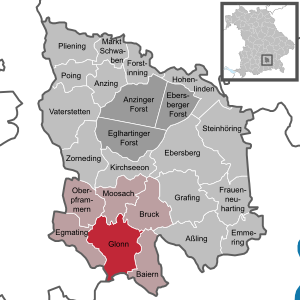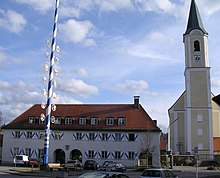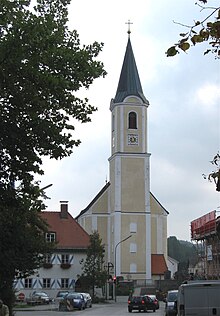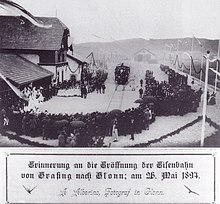Glonn
| coat of arms | Germany map | |
|---|---|---|
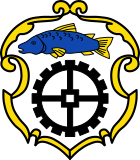
|
Coordinates: 47 ° 59 ' N , 11 ° 52' E |
|
| Basic data | ||
| State : | Bavaria | |
| Administrative region : | Upper Bavaria | |
| County : | Ebersberg | |
| Management Community : | Glonn | |
| Height : | 536 m above sea level NHN | |
| Area : | 30.24 km 2 | |
| Residents: | 5337 (Dec. 31, 2019) | |
| Population density : | 176 inhabitants per km 2 | |
| Postal code : | 85625 | |
| Area code : | 08093 | |
| License plate : | EBE | |
| Community key : | 09 1 75 121 | |
Market administration address : |
Marktplatz 1 85625 Glonn |
|
| Website : | ||
| Mayor : | Josef Oswald ( CSU ) | |
| Location of the market in Glonn in the Ebersberg district | ||
Glonn is a market and state-approved resort in the Upper Bavarian district of Ebersberg and the seat of the administrative association of the same name .
geography
Glonn is located in the Munich region in the foothills of the Alps about 13 km south of Zorneding , 11 km southwest of Grafing , 22 km northwest of Bad Aibling , 26 km north of Miesbach and 30 km from the state capital Munich . For Munich Airport is about 54 km.
Geographical location
The resort Glonn is idyllically embedded in the Glonntal, a former meltwater valley of the former Inn Glacier and is surrounded by wooded hills. In the south, the chain of the Bavarian Alps defines the horizon. The flowing waters of Glonn , Kupferbach and Schrankenbach (Donisbachl) have their sources in the municipality of Glonn . There are a total of four landscape protection areas , partly on the municipal corridor : Kupferbachtal and the surrounding area , Kastenseeon Toteiskessellandschaft , protection of the Kitzelsee and its surroundings, and Steinsee, Moosach, Doblbach, Brucker Moos and surroundings .
Neighboring communities
The neighboring communities of Baiern , Bruck , Egmating , Moosach and Oberpframmern form an administrative community with Glonn .
history
A prehistoric settlement is through a number of finds from the Neolithic , u. a. a living pit as well as weapons and jewelry. The name of the place is derived from the Celtic name of the river "Glana" - the clear.
In the traditional notes of the Bishop of Freising , Glonn is shown in 770 (September 26th) as "(flumen) Clana" and in 774 (March 21st) as "Glan"; this is regarded as the oldest evidence of the establishment of the town. A local nobility “de Glana” has come down to us from around 1015, and in 1349 the church of St. Johann zu Glan appears in the Monumenta Boica overview .
In the 16th century the name changed aloud from "Glon" to today's "Glonn".
In 1632 Glonn was almost completely burned down by the Swedes in the Thirty Years' War . The reconstruction took a long time; the new church was not completed and consecrated until 1823.
Glonn has been a market town since 1901 . There has been electricity in Glonn since 1908, generated by its own hydropower plants in former mills. By 1914, around half of Glonn's residential buildings were electrified.
The place Glonn changed from an agricultural village with little craftsmanship into a modern small center with handcraft and trade for the surrounding communities. Agriculture has declined sharply.
After the Second World War , the settlement structure of Glonn was determined by the integration of the arriving expellees , bombed out and evacuees, who ultimately made up more than a third of the population. Extensive construction work began. In 1959 it was necessary to introduce street names, the house numbers previously assigned were no longer sufficient.
There were repeated floods in Glonn. The worst hit the place in August 2002.
Population development
Between 1988 and 2018 the market grew from 3,680 to 5,276 by 1,596 inhabitants or by 43.4%.
politics
Municipal council
The following parties are active in the municipality with their own local association:
- CSU
- SPD
- Alliance 90 / The Greens
- Local political working group (KOMMA) , which forms a joint list with the SPD during elections.
- Voting group "Glonner for Glonn" (GfG)
In the municipal council , the CSU has 8 seats with the 1st mayor , the SPD / KOMMA 5 seats and the Glonners for Glonn and Bündnis 90 / Die Grünen 2 seats each (as of May 2014 ).
The first mayor is Josef Oswald (CSU).
coat of arms
| Blazon : "In silver a horizontal blue trout with golden fins, including a sixteen-blade black mill wheel." | |
Mill wheel and trout indicate the most prominent features from a landscape and economic point of view:
- the great abundance of water in the Glonntal (Glonn, Kupferbach, Schrankenbach (Donisbachl)) and its side valleys.
- the Glonntal mill trade, which today only exists in four mills, some of which have been shut down, but which used to be an important economic factor beyond local borders with seven mills.
The mill wheel can be seen as a common symbol of agriculture and handicrafts that have always shaped the community of Glonn.
Town twinning
-
 France : There has been a close relationship with the French city of Bonnefamille since 1998. Reciprocal visits by associations and delegations maintain contact.
France : There has been a close relationship with the French city of Bonnefamille since 1998. Reciprocal visits by associations and delegations maintain contact. -
 Germany : At the turn of the year 2006/2007 an inner Bavarian partnership was established with the municipality of Markt Schwaben from the same district. The aim of this unusual connection should be the closer interlinking of the regions of the southern and northern districts separated by the Ebersberg Forest .
Germany : At the turn of the year 2006/2007 an inner Bavarian partnership was established with the municipality of Markt Schwaben from the same district. The aim of this unusual connection should be the closer interlinking of the regions of the southern and northern districts separated by the Ebersberg Forest .
Religions
The Catholic parish of St. Johannes includes Glonn and the six branch communities in the districts of Frauenreuth, Münster, Haslach, Schlacht, Kreuz and Adling. The Glonner pastor is also responsible for Kuratien Berganger and Antholing.
The Evangelical Lutheran Church Community of Grafing - Aßling - Glonn looks after around 3550 Evangelical Christians in its area of activity , which corresponds to around 15% of the total population in these community areas. It is assigned to the Rosenheim dean's office .
There is also a Free Evangelical Congregation with its own regular church services.
In the main town there is the Catholic parish church (St. Johannes Baptist, Rococo building , consecrated in 1823), supplemented by several Catholic branch churches, chapels and prayer rooms in institutions such as the Caritas retirement and nursing home or the youth welfare service at Schloss Zinneberg. A Protestant church (Christ Church) was built in 1968 as a modern round building with an attached community center and parish apartment.
Culture and sights
theatre
Every year in autumn, the Glonn Trachtenverein theater event takes place in the Bürgersaal, and the amateur actors perform local plays in Bavarian dialect in several performances .
Museums
Local museum
The local history museum Glonn , which is open several times a year, offers an insight into the local history. In addition to artifacts from prehistory, paintings and books by local cultural workers can be admired. A true to the original furnished room shows the home of the writer Lena Christ .
Technical monument
The technology monument Stegmühle Glonn in the Mühltal preserves the original electricity- generating pump mill (piston pumps from MAN ) with its over a hundred-year-old technology in a fully functional condition.
Until the mid-1990s, it still generated electricity that was fed into the public grid . It has not been in operation since then, but can be viewed by the owner who lives in the house on request.
Buildings
Zinneberg Castle

The Zinneberg Castle is on the eastern edge of the village on the protruding nose of the eponymous pinnacle mountain only be guessed behind dense tree plantings today. Its history can possibly be traced back to the 11th century, but the sources are very uncertain. It was not until 1332 that the place name "Zinnenberg" was first evidently mentioned in this spelling in a deed of gift to the Preysing family . Later on, the castle was owned by several noble families who were influential in Bavaria.
In 1350 Otto von Pienzenau became lord of the castle on Zinneberg by marriage. Once again by marriage, Zinneberg passed into the possession of the Fuggers in 1596 and remained in their hands for the next 230 years. In 1632, during the Thirty Years' War , Zinneberg Castle was burned down. From this time comes the legend that (today) there is a secret passage between the castle and the place through which some residents could get to safety. The Fugger count Johannes Friedrich had the palace rebuilt as early as 1640. In 1825, the widowed Bavarian Electress Maria Leopoldine , married to Count Ludwig v. Arco , the castle. She had it rebuilt according to her taste, as it can mostly be seen today. From 1850 to 1868 the property came into the possession of the Marquis Fabio von Pallavicini, until he sold it to Friedrich Wilhelm Scanzoni von Lichtenfels. In 1898 Baron Adolf von Büsing-Orville became the new lord of the castle. He took care of further extensions that give the castle its feudal character to this day.
Some street names in the village are reminiscent of this aristocratic history (“Preysingstraße”, “Pienzenauer Straße”, “Fuggerstraße”, “Arcostraße”, “von-Scanzoni-Straße”, “Büssingstraße”).
During the Depression , the goods for 735,000 Reichsmarks became the property of the Good Shepherd Sisters on September 14, 1927 . Today, under their sponsorship, the castle serves as a youth welfare facility for girls from difficult backgrounds and also houses a kindergarten.
Already at the time of the First World War , part of the castle was functioning as a hospital with 60 beds. After the outbreak of the Second World War, the building of the educational home was confiscated as a reserve hospital of the Wehrmacht . During the Cold War , an underground bunker was built, which was intended as a stationary auxiliary hospital (in the extended emergency program).
The castle is currently home to an institution for child and youth welfare with a home for girls and young women, a school for educational assistance and training opportunities. A public kindergarten and after-school care center for the municipality of Glonn is also located in the building.
Parish Church of St. Johann Baptist
The parish church of St. Johann Baptist is a prominent building that the visitor notices prominently in the center of the village when he comes to Glonn from one of the surrounding hills.
John the Baptist as the church patron suggests an early Christian baptismal church. Even before 1600 there is a Gothic church in the middle of the village, the sacristy of today's parish church is still a remnant of this church.
Having fallen into disrepair, the Gothic building was demolished in 1767 and today's church was built between 1768 and 1778, but was not fully completed and consecrated until 1823. The architectural style is rococo . The figures of the high altar as well as a crucifix with Our Lady of Sorrows were created in 1777 by Joseph Götsch (pupil of Ignaz Günther ). The neo-baroque stucco decoration, the Annunciation group on the choir arch and the ceiling paintings were created in 1893. In 1994 the church was extensively renovated.
Monastery school
In 1899 the construction of a girls 'school began in the center of Glonn; on October 24, 1902, it was handed over to the mayor of that time “for the purpose of a girls' school to be run by Catholic women religious”. This task was taken over by the nuns of the Maria Stern monastery from Augsburg .
In the Third Reich , however, they were expelled from school on March 25, 1937. This led to violent protests by the parents and finally called the Gestapo on the scene when a so-called Pentecost (straw doll as a mockery of the ruling regime) was anonymously attached to the roof of the neighboring boys' school on Pentecost Sunday , dressed in the brown shirt of the SA and a communist cap .
After the end of the war the nuns were able to take over teaching again. From 1964, there was a mixed class for the first time after the war.
In the mid-1970s, the market town acquired the now abandoned monastery and school building. In the further course it was developed into a cultural and social center in the town: in the attic which was local history museum housed the "old room" on the ground floor offers a social meeting place for senior citizens , the local chapters of the Red Cross and a nursery with day care find there their place A youth club has established itself in the basement . At times the old classrooms were used again as alternative quarters for the neighboring elementary school when it threatened to burst at the seams with a high number of pupils.
The old chapel with sacristy and ancillary rooms in the western part of the building is used as a gallery for exhibitions. The room can be rented for events and the municipality offers it for civil marriages as an alternative to the usual office space.
The garden to the south of the building was briefly a public children's playground until the fire station of the volunteer fire brigade was located there in 1980 . The northern monastery garden with a fountain was open to the public until 2011 and offered a quiet oasis on site. At the beginning of 2012, the extension of the kindergarten was built on this area, now only the old avenue trees, a field cross and a stone monument at the roadside remind of the former affiliation to the monastery.
Exhibitions, galleries
The gallery in the monastery school offers artists a platform for their works with regular themed exhibitions. These come into their own in the ambience of the former monastery chapel.
In the Friedel scrap gallery you can find all sorts of strange things by an artist from Glonn, who preferably uses scrap metal to create new sculptures that have already found permanent homes in many households. The head-high loach at the entrance to the town next to the car dealership of the same name comes from this workshop. At irregular intervals there are musical samples of unusual bands in the scrap gallery.
The small gallery is another platform for various artists.
nature and landscape
The Kastensee , a popular bathing water area, belongs to the local area of Glonn, and the Steinsee is located directly adjacent to the neighboring municipality of Moosach .
The nature reserve "Kupferbachtal bei Unterlaus" is located near Glonn . Here you can find rare plants such as Bavarian spoonweed .
Leisure and sports facilities
A small indoor swimming pool is maintained in the school building , which can also be used by the population.
Various sports fields are used for physical exercise, the central school sports field and the football field in the Adling district are used for training and point games for the football teams of the ASV (General Sports Club). A basketball field is also open to the Glonn youth outside school hours, as are the two football fields with football goals. A tennis court is also available. Two public children's playgrounds complete the offer for fun and games in Glonn.
The area offers hiking and biking trails , if there is enough snow, the winter sports club operates a cross-country skiing trail with floodlights , and the two small lifts at Finkenhöhe are used by skiers . There are also bathing lakes around the place.
Regular events
Market days have been held four times a year since 1901, on the third Sunday of Lent , on the Sunday before Pentecost , on the first Sunday in August and on the first Sunday in October. This series is complemented by the Christmas market on the second Sunday of Advent and the regular farmers' market every second Saturday of the month from May to October.
On a Saturday in mid-July, visitors to the night flea market populate the main street, mostly in romantic candlelight and lantern light .
The Glonn village festival , which has been jointly organized by the larger Glonn associations since 1992 (Friday to Monday on the first weekend of the Bavarian summer holidays), is known nationwide. Since many Glonnians are members of one of these associations, we have made sure that things get going on these days. The timbered huts protect you from downpours, but when the weather is nice, the open-air spaces in the specially designed area in front of the school are quickly occupied.
A Sunday in September (at the end of the Bavarian summer vacation) is the date for the popular mini triathlon run by the local water rescue service. On one tenth of the Ironman triathlon courses, individual starters as well as groups or families in a team can demonstrate their sportiness in swimming, cycling and running. The start, finish and swim route is Kastensee, the running route leads through the forest around the lake and the bike route through the hilly local area of Glonn.
Economy and Infrastructure
traffic
The municipality of Glonn is crossed by the district roads EBE 13 and EBE 14 and the state roads St 2079 and St 2351 , it is 18 km to the A 8 (junction Weyarn ) and 16 km to the A 99 (junction Ottobrunn ).
The connection to the neighboring towns is guaranteed with several bus lines, which also lead to the S4 and S7 S-Bahn lines to Zorneding and Höhenkirchen-Siegertsbrunn in the Munich Transport and Tariff Association . Glonn belongs to zones 3 and 4 of this tariff system.
From 1894 the Grafing Bahnhof – Glonn local line had its terminus in Glonn, but it was shut down in 1970 due to a lack of passenger traffic and in 1971 in freight traffic. In place of the former train station, there is now a spacious bus stop with two shelters and several stops, the name "Bahnhofplatz" has been retained. The former engine shed still exists and is now used as a residential building. The embankment continues conspicuously through the Glonntal to Moosach, a temporarily planned use with a cycle path on the disused railway line has not yet been implemented.
Resident larger companies
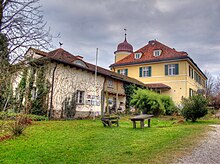
- Herrmannsdorfer Landwerkstätten (food in ecological quality, including the Herrmannsdorfer Schweinsbräu brewery )
- Hans Brunner chocolate molds ( industrially manufactured plastic molds for chocolate and praline manufacturers)
- Bus company Josef Ettenhuber
Public facilities
Glonn is the seat of the municipal administration and the Glonn administrative association .
The responsible district office , district court , police inspection and other authorities are in Ebersberg .
The Ebersberg notaries hold an office day each month in the Glonn town hall (appointments at the municipal administration).
The Allgemeine Ortskrankenkasse offers monthly advice in the town hall.
education
An elementary school ( primary and secondary school ) in Glonn provides education for primary school students in the first four school years and preparation for working life in the next five grades. The preparation and examination for the qualifying secondary school diploma can be taken here. Around 40 teachers teach the 450–500 students from Glonn and the neighboring communities.
The facilities of the girls' boarding school in the monastery of the "Good Shepherds" at Zinneberg Castle include several special offers, from the social pedagogical support group for primary school students to educational assistance (5th to 9th grade) with the possibility of individual learning support up to vocational preparation years and the vocational school for various primarily domestic professions.
The private Yamaha - Music School "Kling Glonn" offers music lessons for all ages.
Other facilities
- Community library Glonn
- Citizens' Hall
-
Kindergartens :
- Parish kindergarten (operator: Catholic parish)
- Community kindergarten and day-care center at Schloss Zinneberg (operator: Arbeiterwohlfahrt )
- KiJuFa kindergarten with day-care center and lunchtime supervision (operator: KiJuFa, Friends of Children, Youth and Families in Glonn eV)
- Kindergarten in Herrmannsdorf (sponsor: Parents' Initiative Kindergarten in Herrmannsdorf eV)
- Caritas - "Marienheim" retirement home
- Volunteer fire brigade Glonn ( fire brigade ), with the district fire brigades Frauenreuth, Schlacht-Kastenseeon and Mattenhofen-Haslach (one fire fighting group each )
Personalities
Sons and daughters of the place
- Michael and Johann Beham, artists & restorers
- Wolfgang Wagner senior (born November 15, 1834, † February 6, 1902), member of the Bavarian State Parliament and the German Reichstag
- Wolfgang Wagner junior (born May 9, 1865, † August 8, 1912), member of the Bavarian State Parliament for the German Center Party 1907–1912
- Lena Christ (born October 30, 1881, † June 30, 1920), writer
- Max Lebsche (born September 11, 1886, † September 22, 1957), doctor, pioneer of cardiac surgery, founder and chief physician of the Maria Theresia Clinic in Munich
- Georg Lanzenberger (born March 24, 1897, † May 23, 1989), painter, mayor of Glonn 1933–1945
- Karl Koller (* February 22, 1898, † December 22, 1951), pilot, world distance record in 1921 in gliding at 5 kilometers, first 360 ° circular flight with a glider without loss of altitude in 1921, last Chief of Staff of the German Air Force in World War II from November 1944 to End of the war in 1945
- Centa Haas (* December 20, 1908, † July 20, 1976), educator and politician (CSU), member of the German Bundestag 1963–1965
- Richard Gürteler (born June 23, 1936, † October 22, 2000), master baker, Member of the Bavarian State Parliament 1974–1994
Other known citizens
- Franz Kaltner (born May 8, 1721, † September 9, 1766), priest and composer
- Günter Bialas (born July 19, 1907, † July 8, 1995), composer
- Blasius Gerg (born January 16, 1927, † May 17, 2007), sculptor
- Karl Ludwig Schweisfurth (* July 30, 1930 - February 15, 2020), entrepreneur, pioneer of organic food production and processing, founder of the Schweisfurth Foundation and the Herrmannsdorfer Landwerkstätten
- Susanne Osthoff (born March 7, 1962), archaeologist who was kidnapped in Iraq in November 2005 and held hostage for three weeks (her last known German residence until May 2005 was in Glonn)
literature
- Monika Fassrainer (photos): Glonn through the ages . Illustrated book, Geiger, Horb am Neckar 1988, ISBN 3-89264-286-9 .
- Johann-B. Niedermair: Glonn and the surrounding area . 1st edition 1939. Salesianerverlag, Munich; Reprinted in 1989 by the Glonn Cultural Association.
- Wolfgang Koller: History and Stories . Festschrift for the 1200th anniversary in 1974, published by the market town of Glonn.
- Hans Obermair: Property of the market town of Glonn, built before 1900: owners and families. Glonn: self-published 2016.
Web links
- Market town of Glonn / Obb.
- Glonn: Official statistics of the LfStat
- Zinneberg Castle in Glonn: When nuns do business on sueddeutsche.de, accessed on June 13, 2015
Individual evidence
- ↑ "Data 2" sheet, Statistical Report A1200C 202041 Population of the municipalities, districts and administrative districts 1st quarter 2020 (population based on the 2011 census) ( help ).
- ↑ Rudolf Engel: Land between Isar and Inn . With the collaboration of Hermann Dannheimer , Wilhelm Neu, Karl Puchner, Bernhard Schütz, Peter Steiner . Schnell & Steiner, Munich 1975, ISBN 3-7954-0321-9 , pp. 217 .
- ↑ Marktgemeinderat> Committee members (detailed view). Municipality of Glonn, accessed on August 1, 2020 .
- ^ Entry on the Glonn coat of arms in the database of the House of Bavarian History
- ↑ Website of the Kulturverein Markt Glonn eV. Accessed on May 5, 2017 .
- ↑ Archived copy ( Memento from May 23, 2016 in the Internet Archive )
- ↑ Rudolf Engel: Land between Isar and Inn . With the collaboration of Hermann Dannheimer , Wilhelm Neu, Karl Puchner, Bernhard Schütz, Peter Steiner . Schnell & Steiner, Munich 1975, ISBN 3-7954-0321-9 , pp. 218 .
- ^ Grafing-Glonn branch line ( page no longer available , search in web archives )
- ↑ Local railway Grafing-Glonn ( page no longer available , search in web archives )

